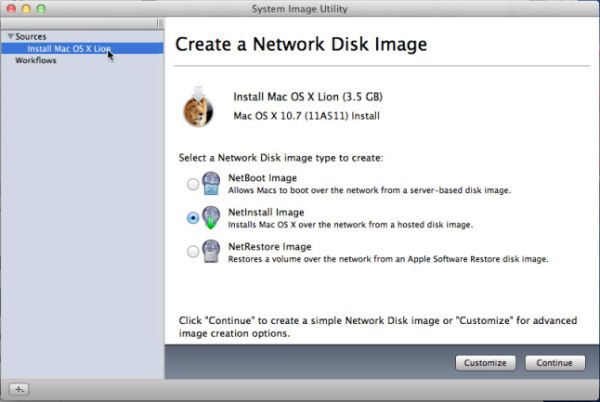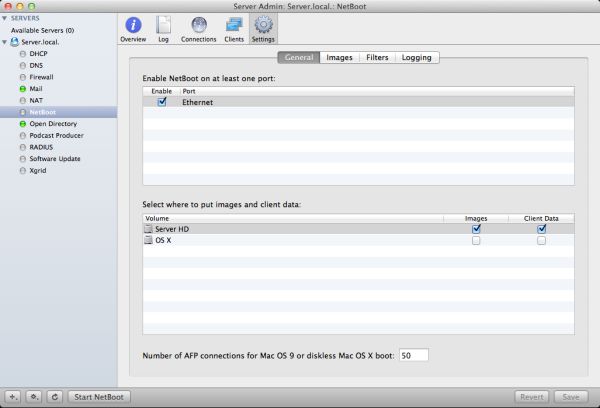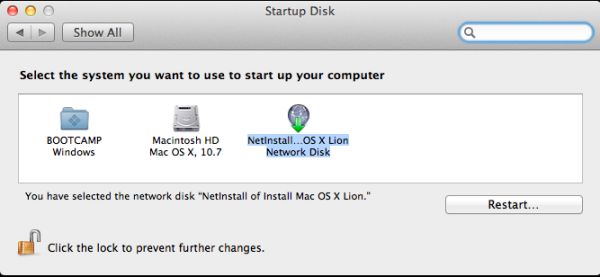In-Depth with Mac OS X Lion Server
by Andrew Cunningham on August 2, 2011 8:00 AM ESTNetBoot
The NetBoot service is one of my personal favorites - using a mix of standard PXE boot technology and some of Apple’s own mumbo-jumbo, you can use it to serve up OS images to client Macs over the network. Its uses are diverse - you can boot up a simple operating system designed to deploy OS X images to multiple computers at once (I recommend the excellent, free DeployStudio for this sort of work), you can serve up a vanilla OS X install disk, or you can use the System Image Utility (another of the Server Admin Tools) to capture a pre-configured OS X environment that can be served to many clients at once - the latter is particularly useful in classrooms, computer labs, public-use kiosks, and anywhere with a lot of Macs that need to look and act the same, since getting a clean instance of the OS is as easy as rebooting the system.
The actual setup and operation of the NetBoot service is basically identical to the way it was in Snow Leopard server (which looked a lot like Leopard’s implementation did, and so on). However, there are some inconveniences related to Lion’s dropping of support for Core Duo and Solo Macs if you’ve still got any hanging around - a bit of historical context will be useful here.
NetBoot dealt with the PPC-to-Intel transition by allowing administrators to choose what client architecture a particular image would boot - if you made one 10.4 NetBoot image for PowerPC systems and an equivalent image for Intel systems, you could set them both as the default images for their respective architectures, and offer the same services to all of your Macs regardless of architecture without incurring too much additional overhead.
10.5 made Universal images possible - these were simple times, because one image could boot basically all of your supported Macs (as long as you didn’t have any super-old G3s or G4s around), but you had to go back to the image-per-architecture model when 10.6 dropped support for PowerPC. It was a little extra work, but was totally doable.
As we discussed before, 10.7 drops support for the very earliest of the Intel Macs, but your Netboot architecture options remain the same - you can pick PowerPC, Intel, or Universal (for 10.5 images), but you can’t distinguish between supported and unsupported Intel Macs.
Granted, this problem will affect only a subset of Lion Server users - those who use NetBoot and need to support both the newest Macs (necessitating a recent 10.7 image, since as a rule OS X isn’t downgradeable) and a mix of older Macs - if this roughly describes your situation, begin devising workarounds now.
Using the System Image Utility
If you have several Macs on your network and are worried about Lion’s lack of restore media (and if, for some reason, you don’t want to make your own restore DVD or USB stick as we discussed in our Lion review), the NetBoot service provides you with one of the few supported methods for getting around it.
All you need to do is keep a copy of the Lion installer downloaded from the App Store. As long as you’ve got it stored somewhere on a drive that is readable by the computer, you can fire up the System Image Utility and see it listed as an image source.
Go ahead and create a basic NetInstall image of it, and save the resultant *.nbi folder to your server's \Library\NetBoot\NetBootSP0 folder, and then enable it in the Images tab in Server Admin (note that the NetBoot folder is only created once you choose to store images and client data on your hard drive in Server Admin, and that your images only become visible to clients when you’ve enabled NetBoot on your server’s Ethernet port).
Enabling ports and storage locations
Once everything is enabled, you should see your new NetBoot image as an option in the Startup Disk preference pane on your client Macs.
You can use the System Image Utility to make a NetBootable image of any OS X partition, as long as it’s running the same version of OS X as the Mac running the System Image Utility - Lion can make Lion boot images, Snow Leopard can make Snow Leopard boot images, and so on.
Software Update
Software Update downloads every update in Apple’s catalog and allows you to serve them up to your users. This includes every product updated by Software Update: OS X (versions 10.5, 10.6, and 10.7 are supported), Final Cut, iLife, iWork, and various firmware updates included. With Final Cut and others making the transition to the App Store, it’s uncertain whether Software Update will continue to offer updates for these products. Another question is whether iOS updates will be offered via Software Update once over-the-air delta updates become the norm in iOS 5 - as usual, we’ll have to wait and see.
The other advantage is that you can choose exactly which updates to serve to your clients. If, for example, you know that 10.7.1 deletes user data, or that iTunes 10.5 is going to have problems that are fixed days later by iTunes 10.5.1, or that Safari 5.2 causes problems with some internal sites you depend on, you can uncheck those updates and elect only to serve them up after issues have been fixed.
All you have to do is point your client computers to your Software Update server. This is easily done via policies in Workgroup Manager or Profile Manager for managed Macs, or via some command line trickery for non-managed Macs. Downloading the entire update catalog does consume a fair amount of disk space, so make sure you've got a few dozen spare GB on your drive somewhere before turning the service on.















77 Comments
View All Comments
ex2bot - Friday, August 5, 2011 - link
Upgrading OS X is not much of a pain, as Repo says. Plus, it's practical to skip at least every other upgrade. So, upgrading every four years (2 + 2) at $60 isn't a big deal and the improvements are worth it.I especially appreciate Expose', Time Machine, Spotlight, and Quick Look and use them regularly And every Mac user has benefitted from Quartz GL (uses 3d graphics card to speed up screen draws).. There have been myriad "invisible" or subtle improvements as well. See Apple's "Mac OS X" section for details.
Four years between OS upgrades is not bad, as I said. Longhorn was supposed to come out about 4 or 5 years after XP. Microsoft just had eyes bigger than its stomach and it was delayed. But Windows 7 was worth the wait. Especially features like the display compositor + aesthetically pleasing UI + improved security (and no more yellow speech bubbles popping up all the time)
Ex2bot
Automated System Process
ex2bot - Friday, August 5, 2011 - link
BTW, Expose's successor is called "Mission Control."Sahrin - Tuesday, August 2, 2011 - link
a reduction in advertising, if you guys are going to do all these paid reviews for Apple.Johnmcl7 - Tuesday, August 2, 2011 - link
It's getting a bit of a joke these days that anything with the Apple badge will get a news article, preview, in depth review the moment it's out dwarfing everything else which barely seems to get a look-in. I get that Anand likes Apple stuff and if I don't I should go elsewhere but I like the non-Apple reviews when they do occasionally get published.John
ex2bot - Friday, August 5, 2011 - link
It's no joke. Check Anand's mailbox some time*.Ex2bot
*Crazies, please don't mess with his mailbox.
ex2bot - Friday, August 5, 2011 - link
I know for a fact that Apple employees stuff money into Anand's mailbox*. Lots and lots of money. They use $20s and $50s straight from Jobs' car, who burns them to light his cigs.Ex2bot
Currency Calculating Mac Fanbot
* Anand, I don't really believe this. I was kidding, as I'm sure you've figured out. Actually, I'm sure they are $100s, not $20s and $50s. After all, he's a Billionaire.
the_engineer - Tuesday, August 2, 2011 - link
Thanks for this great in-depth look at Lion Servers new & continued functionality, I learned a lot reading this. However, I'm still very confused at where XSAN fits into the picture. As a storage power-user I've used software Linux raid, semi-hardware windows raid (Intel, Highpoint), and I've lately dabbled into ZFS because it seems like it's really got everything I could ever want as far as straight storage capabilities are concerned (I'm running a raidz6 with 6 750GB drives currently running on Nexenta). I'd really like to put Lion Server on a mac and install a generic SATA card and add 6 3TB hard drives and do a great big raid5 in a mac pro, but am very confused as to whether or not this will work. I was very hopeful that Lion Server would integrate 'software' RAID5 or similar functionality, but it's not clear anywhere whether it does this or not. Simply put, Do I still need to buy a dedicated raid5 card to have a redundant array of inexpensive disks on a mac or am I missing something still?-Looking for a great user experience AND a ton of redundant storage
HMTK - Wednesday, August 3, 2011 - link
Why not set up a NAS with iSCSI or NFS ?the_engineer - Wednesday, August 3, 2011 - link
LONG story short, geting a deidciated NAS box means spending more money than ought to be necessary at this point (I have an i7 desktop and a core2 desktop, both capable of running Lion, Windows, FreeBSD, you name it... Just fine, as well as plenty of vanilla SATA ports & cards available). I'm Trying to weigh all purely software options available to me, with ZFS/BSD sitting on top of the heap for storage features but OSX sitting on top of the heap from a usability standpoint. The longer I look at it the more likely I am to end up running one huge 20-drive ZFS based NAS under FreeBSD but was trying to avoid getting to this point.HMTK - Wednesday, August 3, 2011 - link
If you put it on the network you can access it with all decent OS's. I've got a little HP mini proliant just for that.